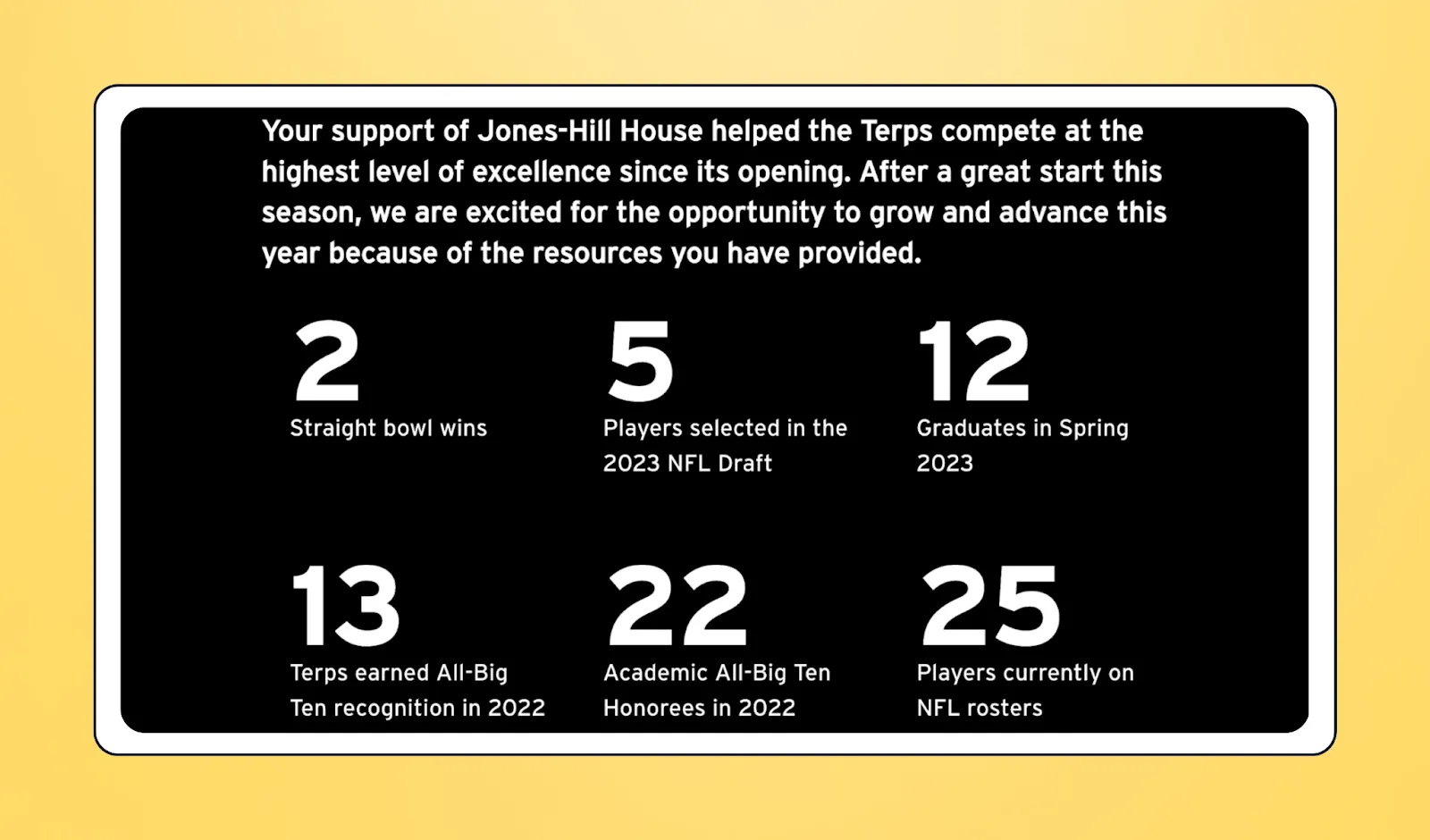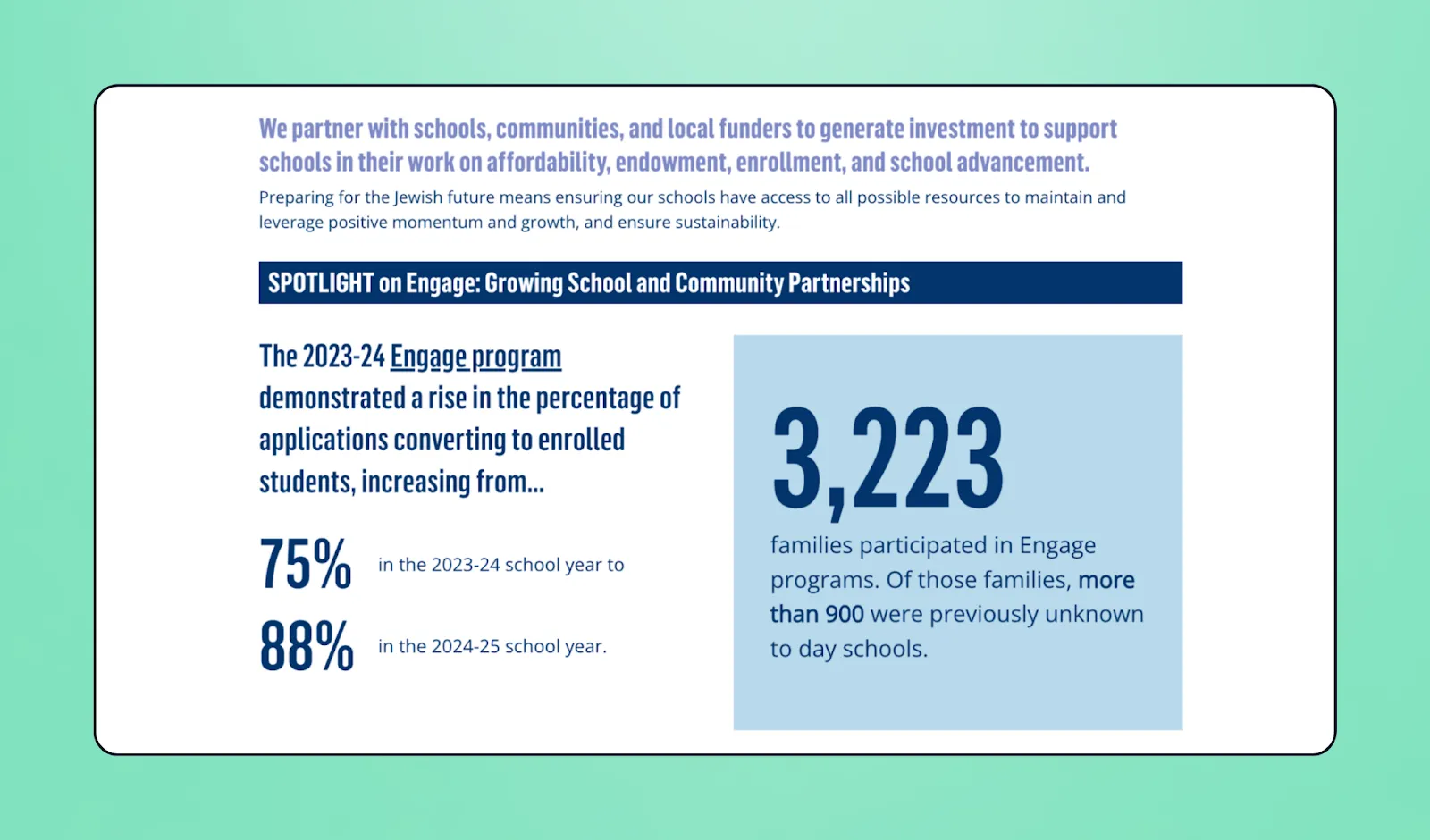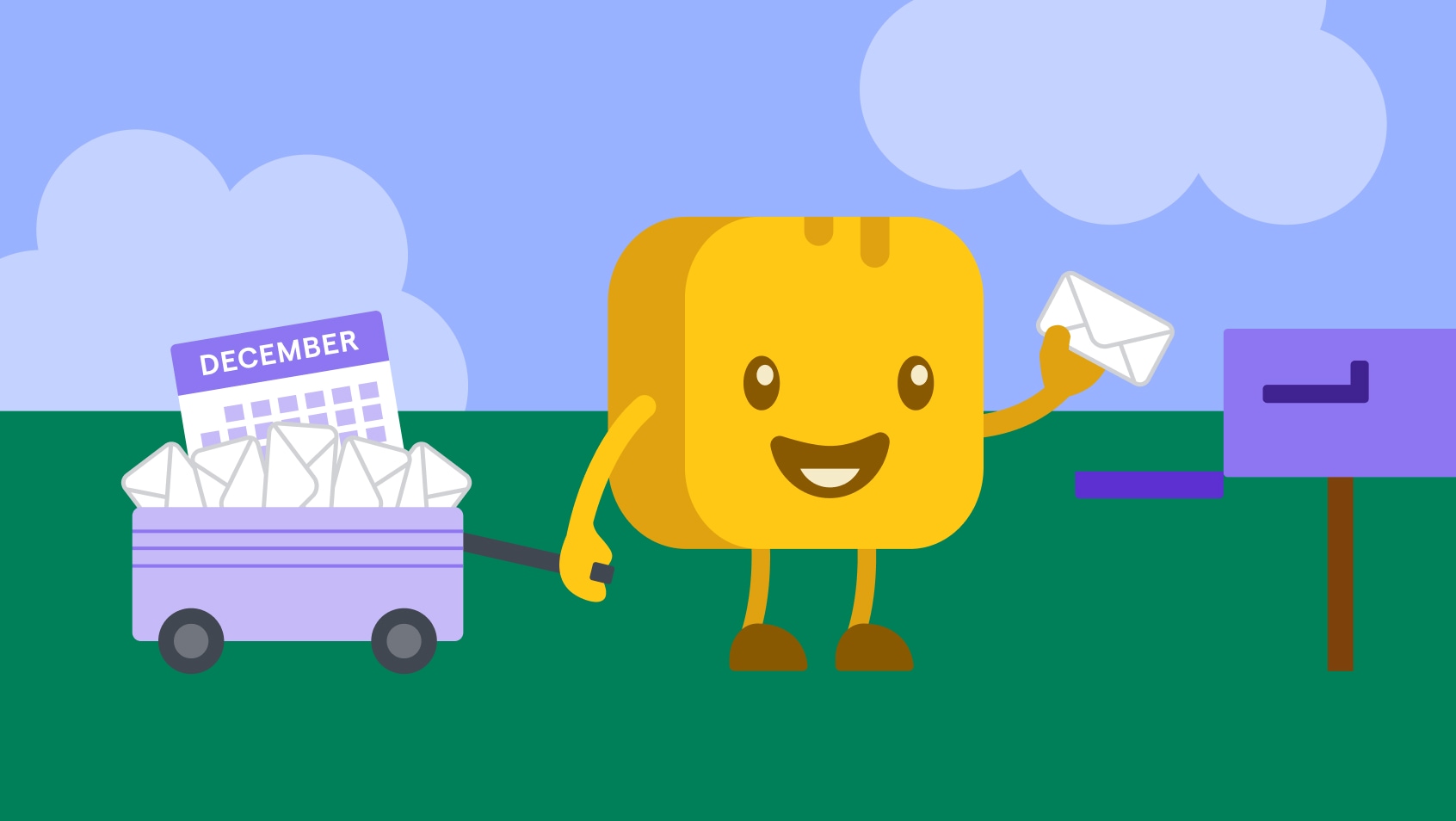Table of contents
Table of contents
Your nonprofit makes an incredible impact every day—but do your supporters see it? An impact report transforms your results into a compelling story of change, demonstrating to donors precisely how their gifts have made a difference.
In this guide, you’ll learn what a nonprofit impact report is, how it differs from an annual report, and how to create one that’s visual, transparent, and donor-centered. You’ll also find examples, templates, and design tips to help you share your impact clearly and inspire even more giving.
Key takeaways
- Create impact reports to celebrate success 🥳 While annual reports cover finances, operations, and organizational updates, impact reports focus specifically on donor-funded results, community change, and the tangible effects of giving.
- Leverage your impact reports to build donor relationships 💪 Showcasing your success with data, stories, and visuals builds transparency, reinforces your mission, and keeps supporters engaged.
- Focus on outcomes and storytelling 📈 Identify 3-5 meaningful success metrics, gather both quantitative data and qualitative stories with proper consent, and make supporters the stars.
- Design your report for clarity and accessibility 🎨 Use simple visuals, strong contrast, and concise layouts to make your impact report skimmable and easy to share.
- Share your report widely to boost engagement 📣 Distribute it across email, text, social, and your website to reach supporters across every channel they use.
- Maximize your reach with Givebutter 🧈 Track outcomes, segment supporters, and share your report with free CRM and marketing tools that make stewardship stress-free.
What is an impact report for nonprofits?
An impact report is a donor-centered summary that highlights how contributions made a real difference. It connects gifts directly to outcomes, stories, and measurable results. Impact reports serve as a powerful touchpoint, essential for effective donor stewardship.
Unlike annual reports, which cover everything that happens in a year (including finances, operations, and organizational updates), an impact report focuses on donor-funded results, community change, and expressing gratitude.
Why is a nonprofit impact report important?
A nonprofit impact report highlights the change you created in your community and gives supporters a clear view of how their generosity made it possible. It also strengthens long-term donor engagement by helping you:
- Reinforce your mission 💡 Reiterating your goals and sharing lessons learned for future programs reminds supporters exactly why your work matters.
- Build trust and transparency 💛 Keep supporters informed by highlighting your success through data, stories, and visuals. Demonstrating transparency and commitment to your cause creates a foundation of trust.
- Strengthen donor relationships 💪 When donors can see the real results of their contributions, it deepens the connection and encourages continued support.
- Track organizational progress 📈 Impact reports help your team measure growth and progress over time, offering valuable insights for your strategy.
When to send your nonprofit impact report
One of the best things about an impact report is its flexibility, unlike annual reports that are typically sent once a year. In general, nonprofits tend to share impact reports:
- At the end of the year 📅 Annual impact reports are perfect for summarizing annual impact and reinforcing year-end giving campaigns.
- After a major campaign or fundraiser 📈 Show donors the results of their support while excitement is high.
- Following milestones or anniversaries 🎉 Highlight achievements on organizational milestones or program anniversaries.
- Quarterly or mid-year 📊 Keep recurring donors engaged with progress reports and updates throughout the year.
How to write an impact report in 5 steps
Impact reports are one of the best ways to keep supporters updated on your work—but how do you plan, write, and share one? Follow these five steps to take you from start to finish.
1. Define what success looks like for your nonprofit 📊
Your nonprofit impact report should tell the story of what your organization has achieved or is working toward.
Start by choosing 3-5 success metrics that reflect meaningful impact for your organization over a specific period of time, such as the calendar year or fiscal year. Focus on outcomes that show real impact rather than just outputs, e.g., number of people served or volunteer hours contributed.
💡 Pro tip: When gathering data for your report, keep your audience in mind. If you’re creating an impact report specifically for donors, focus on gratitude and outcomes. If you’re creating one for grant funders, you might want to include more quantitative results. Tailoring your focus makes your report more effective.
2. Collect stories and data that shine 💬
Nonprofit impact reports blend valuable data with powerful stories and visuals. To ensure your data and content are top-notch, be sure to:
- Use multiple sources 📝 Gather insights from surveys, interviews, program evaluations, and CRM exports to capture both quantitative (e.g., numbers, percentages, metrics) and qualitative (e.g., personal stories, testimonials, feedback) data.
- Clean and organize your data 🧹 Review your data for accuracy, remove duplicates, fill in missing information, and store everything, such as spreadsheets, testimonials, photos, and case studies, in one centralized location.
- Focus on relevance and accuracy 🎯 Highlight the information that supports your stated goals and demonstrates measurable impact. Be sure that none of your data is inflated or misrepresented.
💡Pro tip: Always obtain written permission before using photos, quotes, or personal stories from clients, volunteers, or staff. Be clear about how and where their information will be shared!
3. Write your story with donors at the heart 💛
Take all the data and stories you’ve gathered and turn them into a compelling narrative. Begin by thanking supporters for their generosity. Then, demonstrate impact by connecting donations with real results (both qualitative and quantitative).
End with a call to continue the journey, inviting supporters to keep making a difference, reinforcing ongoing engagement, and giving. Whether your impact report is designed for funders or everyday donors, be sure to position them as the heroes of the story and the key ingredient to the success of your mission.
4. Design it to be seen and shared 🎨
A strong design can make all the difference. Keep it engaging by focusing on:
- Visual data 📊 Use charts, infographics, or icon rows to make numbers easy to digest and visually appealing.
- Context and quotes 🗺️ Include a mini map, timeline, or before-and-after photos to show your impact geographically or over time. Feature short testimonials or standout quotes from beneficiaries, volunteers, or donors.
- Prioritize accessibility 🌈 Use readable color contrast, legible fonts, and alt text for all images so everyone can engage with your report.
💡 Pro tip: Tools like Canva for nonprofits make it simple to create engaging, visually appealing graphics with easy templates and design like a pro!
5. Share, measure, and keep improving 📈
Once your impact report is created, don't stop there! Share it strategically, tracking your successes and adjusting as needed:
- Create a multi-channel plan 📣 Distribute your report through email, text, social media, and your website for maximum reach. Consider which donor segments should receive each version.
- Track engagement 🔗 Monitor clicks, downloads, and shares to see which channels and messages resonate most.
- Analyze and refine 📊 Try A/B subject lines, headlines, or call-to-actions to optimize engagement and open rates. Review metrics and feedback to refine future reports.
💡 Pro tip: Use Givebutter’s free nonprofit marketing software to reach supporters and tell them all about your newly published report. Send personalized texts, videos, and emails based on their individual habits and preferences.
Explore interactive nonprofit impact report templates
Impact reports are a powerful tool for connecting with your community. Plus, they can be completely customized to match your nonprofit’s brand, mission, and goals.
With platforms like Storyraise, nonprofits can create custom, professional, interactive impact and annual reports featuring images, videos, and graphs. You can even embedded Givebutter donate buttons and other powerful widgets!
3 effective impact report examples by format
Not all impact reports look alike. In fact, plenty of nonprofits take creativity to the next level and experiment with different formats, from interactive digital reports to sleek one-pagers. To find the right fit for your organization, take a look at these stand-out examples.
1. One-page impact report 📃
While the University of Maryland’s impact report spans a few pages, its key data is showcased boldly on one succinct page, giving supporters a quick, eye-catching snapshot of their impact.

⭐ Why it works: This condensed report gets straight to the point, giving supporters all the info they need, without having to scroll through dozens of copy-heavy pages.
💪 Try this: Review your data and highlight the top five takeaways you want stakeholders to remember. Then, use a Canva template to design your own one-page report!
2. Video impact report 📹
University of Michigan’s video impact report takes storytelling to a new level. Testimonies from scholarship students and alumni (shared in their own words!) create an authentic connection.

⭐ Why it works: Video is dynamic, easily consumable, and entertaining, making it ideal for creating an emotional connection.
💪 Try this: Record beneficiaries, volunteers, or staff members talking about what your mission means to them and how it's making a difference. Add captions and music for extra polish.
3. Interactive impact report 👀
The Prizmah Network’s high-quality impact report raises the bar on engagement with an interactive experience. As readers scroll, impact numbers load in real time, making donors feel like a part of the action.

⭐ Why it works: Interactive reports immerse supporters in your impact, encouraging them to further engage with your content—either to continue reading, clicking, or scrolling!
💪 Try this: Use Givebutter’s Storyraise integration to easily incorporate interactive elements right into an impact report sample (no technical or design skills needed!).
Maximize the reach of your nonprofit impact report with Givebutter
Impact reporting is a fantastic way to show your community that you care about their contributions and that they’re truly the heroes in your nonprofit’s story.
With Givebutter, marketing your custom impact report is as smooth as butter. From simple segmentation for building lists to built-in marketing engagement tools for personalized outreach via email, SMS, and more, Givebutter lets you reach your supporters exactly where they are and without the stress.
.png)
Power your impact reports with free marketing software
Make your impact report go even further. Sign up for free and give Givebutter a try today.
FAQs about donor impact reports
How do I collect data for my impact report if our tracking isn’t perfect?
Start with what you can verify, like program data, service counts, CRM exports, surveys, intake forms, or interviews. When numbers are incomplete, use clear proxies (“estimated based on…”) or qualitative insights. Never guess or inflate results. Transparency builds donor trust.
What if our impact this year wasn’t substantial?
Be honest. Donors appreciate transparency about challenges, waitlists, staffing gaps, or lessons learned. Sharing what you’re improving next year can actually increase trust and retention.
How do I choose the right metrics?
Work backwards from your mission and your audience. Donors care most about outcomes, not activities. Instead of “We held 42 workshops,” try “87% of participants reported increased confidence.” Pick 3–5 metrics that demonstrate change rather than effort.
How long should a nonprofit impact report be?
Aim for 1–4 pages or a short scrollable webpage. Donors overwhelmingly prefer short, visual, skimmable content over dense PDFs.
.svg)






%20(1).png)



.svg)











.jpg)



